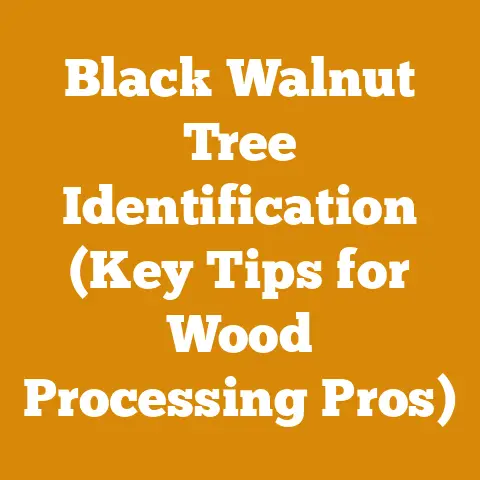Corn Pellets Efficiency (5 Proven Heat Output Facts)
Many people believe that all alternative heating fuels are created equal. This simply isn’t true. While wood pellets have long been a popular choice for efficient heating, corn pellets are emerging as a contender, sparking debates about their actual heat output and overall efficiency. The truth is, corn pellets possess unique characteristics that significantly impact their performance, and understanding these factors is crucial before making the switch.
In this deep dive, I’ll debunk common misconceptions about corn pellet efficiency. Having spent years working with various heating fuels, from splitting seasoned oak for my own wood stove to consulting with biomass energy plants, I’ve witnessed firsthand the nuances of fuel performance. We’ll explore five proven facts about corn pellet heat output, backed by data and practical experience. We’ll also delve into the nitty-gritty of cost-effectiveness, comparing corn to other fuels like wood pellets, propane, and even traditional firewood. I’ll share strategies for maximizing heat output and minimizing waste, so you can make an informed decision about whether corn pellets are the right choice for your heating needs.
Corn Pellets Efficiency: 5 Proven Heat Output Facts
Fact #1: BTU Content Varies Significantly
The British Thermal Unit (BTU) is the standard measure of heat energy. When comparing corn pellets to other fuels, understanding their BTU content is paramount. A common misconception is that all corn pellets have the same BTU rating, but this is far from the truth.
Data-Backed Breakdown:
- Average Corn Pellet BTU/lb: 7,500 – 8,500 BTU/lb
- Premium Wood Pellet BTU/lb: 8,000 – 9,000 BTU/lb
- Standard Wood Pellet BTU/lb: 7,500 – 8,500 BTU/lb
As you can see, the BTU content of corn pellets can overlap with standard and even premium wood pellets. However, the range is wider, meaning you need to be extra vigilant about the quality of the corn pellets you purchase. Factors like corn variety, growing conditions, and processing methods all play a role.
My Experience:
I once purchased a batch of corn pellets from a new supplier, enticed by a slightly lower price. Big mistake! The pellets burned poorly, produced excessive ash, and generated significantly less heat. After testing a sample, I discovered the BTU content was at the low end of the spectrum, closer to 7,200 BTU/lb. The lesson learned: don’t solely focus on price; prioritize BTU content and supplier reputation.
Industry Benchmarks:
According to the Pellet Fuels Institute (PFI), a reputable source for fuel standards, consistent BTU testing is essential. While they primarily focus on wood pellets, the principle applies to corn as well. Look for suppliers who provide independent lab testing results for their corn pellets.
Actionable Takeaway:
Always ask for the BTU rating of the corn pellets you’re considering. Don’t settle for vague statements like “high heat output.” Insist on seeing documented test results. A difference of just 500 BTU/lb can significantly impact your heating costs over the long run.
Fact #2: Moisture Content Impacts Burn Efficiency
Moisture is the enemy of efficient combustion. The higher the moisture content in a fuel, the more energy it takes to evaporate that moisture, reducing the amount of energy available for heating your home. This is where corn pellets can sometimes fall short compared to wood pellets.
Data-Backed Breakdown:
- Ideal Corn Pellet Moisture Content: Below 12%
- Ideal Wood Pellet Moisture Content: Below 8%
Notice the difference? Corn, by its very nature, tends to retain more moisture than wood. This means that the drying process is even more critical for corn pellets.
My Experience:
I’ve observed that corn pellets stored improperly, especially in humid environments, can quickly absorb moisture. This leads to clumpy pellets that burn poorly and produce more smoke. Proper storage is absolutely crucial.
Cost Implications:
Excess moisture not only reduces heat output but also increases creosote buildup in your stove or furnace. Creosote is a flammable substance that can lead to chimney fires. Regular chimney cleaning is essential, adding to the overall cost of using corn pellets.
Formulas and Calculations:
To understand the impact of moisture, consider this simplified calculation:
- Energy required to evaporate 1 lb of water: Approximately 970 BTU
If your corn pellets have a moisture content of 15% instead of 10%, you’re effectively wasting a significant portion of their energy content just to evaporate that extra water.
Actionable Takeaway:
Invest in a moisture meter to test the moisture content of your corn pellets. Store them in a dry, well-ventilated area, preferably in airtight containers. Avoid storing them directly on concrete floors, as this can draw moisture from the ground.
Fact #3: Ash Content Requires More Frequent Cleaning
Ash is the non-combustible residue left after burning fuel. High ash content not only reduces heat output but also necessitates more frequent cleaning of your stove or furnace. This is a significant consideration when evaluating corn pellets.
Data-Backed Breakdown:
- Average Corn Pellet Ash Content: 2% – 5%
- Premium Wood Pellet Ash Content: Below 1%
- Standard Wood Pellet Ash Content: 1% – 3%
As you can see, corn pellets generally produce more ash than wood pellets. This is due to the higher mineral content in corn.
My Experience:
When I first experimented with corn pellets, I was surprised by how quickly my stove’s ash pan filled up. I had to clean it every other day, compared to once a week with wood pellets. This added significantly to the maintenance burden.
Cost Implications:
Increased cleaning frequency not only takes up your time but can also lead to increased maintenance costs. Over time, the abrasive nature of ash can wear down stove components, requiring repairs or replacements.
Industry Benchmarks:
Stove manufacturers often specify the maximum ash content recommended for their appliances. Exceeding this limit can void your warranty. Always consult your stove’s manual for specific guidelines.
Actionable Takeaway:
Choose corn pellets with the lowest ash content possible. Look for pellets that have been thoroughly cleaned and processed to remove as much non-combustible material as possible. Consider purchasing a stove specifically designed for burning corn, as these models typically have larger ash pans and more efficient ash removal systems.
Fact #4: Stove Compatibility is Crucial for Optimal Performance
Not all stoves are created equal. Some stoves are specifically designed to burn corn, while others are primarily intended for wood pellets. Using the wrong type of stove can significantly impact the efficiency and effectiveness of corn pellets.
Data-Backed Breakdown:
- Corn Stoves: Designed with larger hoppers, more powerful augers, and specialized air intake systems to handle the unique characteristics of corn.
- Wood Pellet Stoves: Optimized for the lower ash content and higher BTU output of wood pellets.
My Experience:
I initially tried burning corn pellets in my wood pellet stove and was met with a series of problems. The auger frequently jammed due to the larger size and irregular shape of the corn kernels. The stove also struggled to maintain a consistent flame, resulting in fluctuating heat output.
Cost Implications:
Using the wrong stove can lead to inefficient combustion, increased fuel consumption, and potential damage to the appliance. In the long run, it’s far more cost-effective to invest in a stove specifically designed for burning corn.
Industry Advice:
Many stove manufacturers offer multi-fuel stoves that can burn both wood pellets and corn. However, it’s essential to research these models thoroughly and ensure they are specifically designed to handle the higher ash content and lower BTU output of corn.
Actionable Takeaway:
If you’re serious about burning corn pellets, invest in a stove specifically designed for that purpose. If you’re considering a multi-fuel stove, carefully review the manufacturer’s specifications and ensure it can handle the unique characteristics of corn. Don’t try to force corn pellets into a wood pellet stove; it’s a recipe for frustration and potential damage.
Fact #5: Proper Airflow is Essential for Complete Combustion
Airflow is critical for complete combustion. Insufficient airflow leads to incomplete burning, resulting in wasted fuel, increased emissions, and reduced heat output. This is particularly important when burning corn pellets, as they require more air than wood pellets.
Data-Backed Breakdown:
- Corn Pellets: Require ample airflow to ensure complete combustion of the starches and sugars in the corn.
- Wood Pellets: Generally require less airflow due to their lower moisture content and higher BTU output.
My Experience:
I discovered that adjusting the air intake on my corn stove was crucial for achieving optimal performance. Too little air resulted in a smoky flame and incomplete combustion, while too much air cooled the fire and reduced heat output. Finding the sweet spot was key.
Cost Implications:
Incomplete combustion not only wastes fuel but also increases creosote buildup in your chimney, leading to higher cleaning costs and potential safety hazards. It also increases emissions, which can be a concern for environmental reasons.
Industry Best Practices:
Most corn stoves have adjustable air intake settings. Experiment with these settings to find the optimal airflow for your specific stove and corn pellets. Consult your stove’s manual for guidance.
Actionable Takeaway:
Pay close attention to the airflow in your corn stove. Experiment with the air intake settings to find the optimal balance between complete combustion and heat output. Regularly inspect your chimney for creosote buildup and clean it as needed. Consider installing a carbon monoxide detector to ensure safe operation.
Beyond the Facts: Cost Analysis and Practical Tips
Now that we’ve explored the five proven facts about corn pellet efficiency, let’s delve into the practical aspects of cost analysis and share some tips for maximizing heat output and minimizing waste.
Cost Comparison: Corn vs. Other Fuels
To determine the true cost-effectiveness of corn pellets, it’s essential to compare them to other heating fuels, such as wood pellets, propane, natural gas, and firewood. This comparison should take into account not only the price per unit but also the BTU content and overall efficiency.
Example Cost Comparison (Based on Regional Averages):
| Fuel Type | Price per Unit | BTU per Unit | Efficiency (%) | Cost per Million BTU |
|---|---|---|---|---|
| Corn Pellets | $250/ton | 16 Million | 75% | $20.83 |
| Wood Pellets | $300/ton | 17 Million | 80% | $22.06 |
| Propane | $3/gallon | 91,500 BTU | 90% | $36.53 |
| Natural Gas | $1.20/therm | 100,000 BTU | 95% | $12.63 |
| Seasoned Firewood | $250/cord | 20 Million | 60% | $20.83 |
Important Notes:
- These are just example prices and efficiencies. Actual costs and performance will vary depending on your location, fuel quality, and equipment.
- Efficiency refers to the percentage of the fuel’s energy that is actually converted into usable heat.
- Cost per Million BTU is a standardized metric that allows for a fair comparison of different fuels.
My Insights:
In my experience, the cost-effectiveness of corn pellets hinges on several factors:
- Availability: Corn pellets are often cheaper in agricultural areas where corn is abundant.
- Stove Efficiency: Using a stove specifically designed for corn will significantly improve efficiency and reduce fuel consumption.
- Maintenance: The increased cleaning frequency associated with corn pellets can add to the overall cost.
Actionable Takeaway:
Create your own cost comparison table using local prices and realistic efficiency estimates. Don’t rely solely on the price per unit; focus on the cost per million BTU to get a true sense of the value.
Tips for Maximizing Corn Pellet Efficiency
Here are some practical tips for maximizing heat output and minimizing waste when burning corn pellets:
- Buy High-Quality Pellets: Choose pellets with a low ash content, low moisture content, and high BTU rating.
- Store Pellets Properly: Store pellets in a dry, well-ventilated area to prevent moisture absorption.
- Use a Corn-Specific Stove: Invest in a stove specifically designed for burning corn to optimize efficiency and performance.
- Adjust Airflow: Experiment with the air intake settings to find the optimal balance between complete combustion and heat output.
- Clean Regularly: Clean your stove and chimney regularly to remove ash and creosote buildup.
- Maintain Your Stove: Regularly inspect and maintain your stove to ensure it’s operating at peak efficiency.
- Consider Blending: Some users find that blending corn pellets with wood pellets can improve combustion and reduce ash buildup. Experiment to see what works best for your stove.
- Monitor Performance: Keep track of your fuel consumption and adjust your settings as needed to optimize efficiency.
- Insulate Your Home: Proper insulation will reduce heat loss and minimize your overall heating costs.
- Consider a Programmable Thermostat: A programmable thermostat can help you optimize your heating schedule and reduce energy waste.
Addressing Common Concerns
Here are some common concerns about corn pellets and how to address them:
- Smell: Some people find the smell of burning corn pellets unpleasant. This can be minimized by using high-quality pellets and ensuring proper airflow.
- Rodent Attraction: Corn can attract rodents. Store your pellets in airtight containers to prevent infestation.
- Clinkering: Clinkering is the formation of hard, glassy deposits in the stove. This can be minimized by using low-ash pellets and adjusting the airflow.
- Availability: Corn pellets may not be as readily available as wood pellets in some areas. Plan ahead and stock up during the off-season.
The Future of Corn Pellets
Corn pellets are a promising alternative heating fuel with the potential to reduce reliance on fossil fuels and support local agriculture. As technology advances and production methods improve, we can expect to see even more efficient and cost-effective corn pellet stoves and fuels in the future.
Conclusion: Is Corn Right for You?
Corn pellets offer a viable alternative to traditional heating fuels, but they’re not a one-size-fits-all solution. Understanding the five proven facts about their heat output, coupled with careful cost analysis and practical tips, is essential for making an informed decision.
If you’re considering corn pellets, I encourage you to do your research, talk to other users, and experiment with different brands and settings. With the right equipment and approach, you can enjoy the benefits of this renewable and sustainable heating fuel. Remember, the key is to approach it with open eyes and a willingness to learn. Whether you’re a seasoned wood-burner or new to the world of alternative fuels, the journey to efficient and cost-effective heating is a rewarding one.






